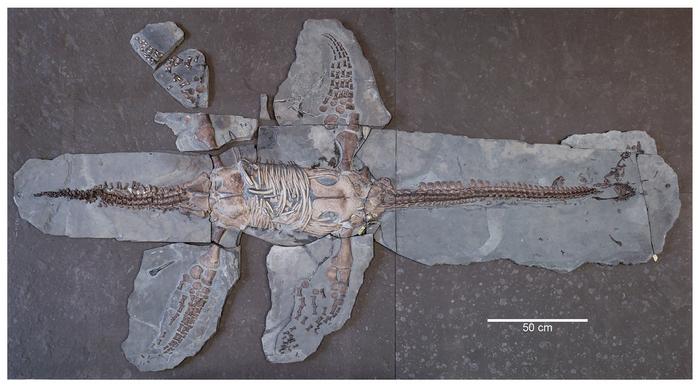A nearly complete specimen of Plesiopterys wildi has emerged from the depths of the Lower Jurassic Posidonienschiefer Formation in southern Germany, offering an unprecedented glimpse into the world of Early Jurassic marine reptiles. This remarkable find not only enriches our understanding of plesiosaur diversity but also sheds light on regional specializations that may have occurred during a pivotal time in the history of these ancient creatures. The discovery of this specimen, named MH 7, is critically important as it represents a significant addition to our understanding of plesiosaur evolution and biogeography.
The specimen MH 7 is distinguished by its remarkable preservation, representing one of the most complete articulated plesiosaur skeletons unearthed in this geological formation. Unlike the more regularly encountered ichthyosaurs and marine crocodile relatives, plesiosaurs are relatively rare in the fossil record of this region. Consequently, the discovery of Plesiopterys wildi not only fills a gap in our knowledge but also highlights the biodiversity that existed among marine reptiles during the Early Jurassic, a period characterized by significant evolutionary experimentation among marine life.
The newly analyzed fossil provides critical insights into the structure of Plesiopterys wildi, which, according to recent phylogenetic studies, is an early-diverging plesiosauroid closely related to Franconiasaurus brevispinus. This finding suggests a gradual evolutionary trajectory towards more derived cryptoclidids, which would come to dominate marine ecosystems in the Late Jurassic. Such insights offer a window into the evolutionary processes that shaped the early forms of these marine reptiles, indicating a complex interplay between environmental factors and evolutionary pressures.
The implications of this fossil discovery extend beyond mere classification. It opens a dialogue about the concept of regional endemism among plesiosaur species during the Early Jurassic. The evidence suggests that different species may have evolved distinctive adaptations and lifestyles in response to unique environmental conditions across the epicontinental seas of Early Jurassic Europe. This geographical segregation highlights the intricate dance between species and their habitats, as well as the potential for varied ecological niches within marine environments of that era.
Moreover, the study underscores the importance of understanding how these ancient reptiles adapted to an ever-changing environment. The fossil record shows that plesiosaurs were beginning to develop specialized anatomical features well before the rise of more derived forms. This indicates that evolutionary adaptations and lineages in marine reptiles were already on distinct trajectories much earlier than previously assumed, which alters our understanding of evolutionary timelines in marine environments.
The specimen’s unveiling comes from an international research collaboration involving credible institutions such as Lund University and Naturkunde-Museum Bielefeld, among others. This collective effort reflects the interdisciplinary nature of paleontological research, which draws on expertise from various fields to build a comprehensive understanding of ancient life forms. Through detailed analysis and comparative studies, researchers are piecing together the evolutionary puzzle of these fascinating marine reptiles, substantially enriching our global narrative of biodiversity.
The intricate details of the fossil — from the anatomical arrangement of the mandible to the positioning of associated skull elements — provide vital data that enrich our morphological understanding of Plesiopterys wildi. The evolutionary implications are extensive, encouraging scientists to rethink established models of plesiosaur evolution and adaptation. The mandible’s anatomy, particularly, illustrates the evolutionary innovations that marked the transition from early marine reptiles to more specialized predator forms.
Key factors influencing this research comprise advanced imaging technologies and refined phylogenetic methods, allowing scientists to analyze morphological features with unprecedented precision. These technological advancements enable researchers not only to visualize fossils in detail but also to construct more resilient evolutionary trees that better represent the dynamic history of life. As the field progresses, the need for efficient methodologies to handle vast amounts of paleontological data becomes increasingly critical.
Further exploration of the Holzmaden formation promises to yield additional specimens that could further illuminate the life histories of plesiosaurs in the Early Jurassic seas. The potential for future discoveries is immense, with each new fossil offering the possibility of answering lingering questions about the ecological roles these ancient reptiles played in their environments. The Plesiopterys wildi specimen serves as a catalyst for future research, driving scientists to unearth further evidence that could bolster our understanding of marine life during this pivotal geological epoch.
In conclusion, the discovery of the Plesiopterys wildi fossil is not merely an addition to the fossil record but a vital piece of evidence encapsulating the transitions and adaptations of marine reptiles during the Early Jurassic. As researchers explore this remarkable find’s implications, it shapes an evolving narrative regarding the evolutionary path of ichthyosaurs and plesiosaurs. The findings affirm that the ongoing study of the fossil record is crucial for deciphering the intricate web of life that has existed on Earth. With each fossil discovery, scientists take another step toward understanding the complex interactions that have been vital in shaping life in our oceans.
To encapsulate, the research surrounding Plesiopterys wildi encapsulates a pivotal moment in paleobiology, revealing that the Early Jurassic was a formative period for the evolution and diversification of marine reptiles. As we glean insights from these ancient specimens, we gain a deeper appreciation for the evolutionary history that continues to shape our understanding of biodiversity today. This work reinforces the notion that with every fossil, we unearth not just the past but also the foundation upon which the narrative of life builds upon.
Subject of Research: Plesiosaur evolution and regional specialization
Article Title: A new specimen of Plesiopterys wildi reveals the diversification of cryptoclidian precursors and possible endemism within European Early Jurassic plesiosaur assemblages
News Publication Date: 31-Mar-2025
Web References: http://dx.doi.org/10.7717/peerj.18960
References: DOI: 10.7717/peerj.18960
Image Credits: Credit: DOI: 10.7717/peerj.18960/fig-3
Keywords: Plesiosaur, Plesiopterys wildi, evolution, fossil discovery, regional specialization, Early Jurassic, marine reptiles, paleobiology.




